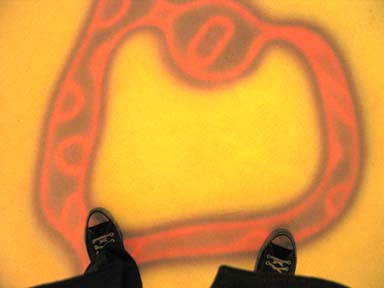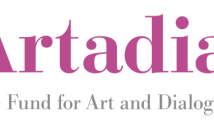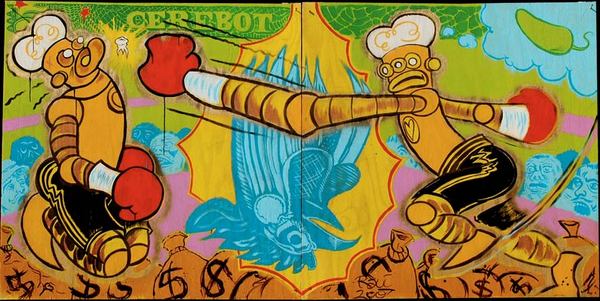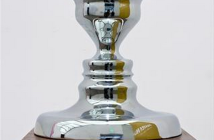FEED - Artists and Digital Influence: a show around the theme of artists who use technology in creation of their work. Thirty or forty years ago this might have been a exciting topic to build a show around, with maybe ten or twenty artists doing really exciting work aided by the use of then cutting edge technology.
Now, its a much harder sell.
Artists have been using technology for decades in the creation their work and the number of artists who are influenced by digital technologies is impossible to gauge. Perhaps the days of shows attempting to survey the of landscape of digital art needs to come to end and more focused views needs to take place. I'm thinking here of specific themes such as Post Digital Painting (an exhibition at Cranbrook from 2003 featuring Carl Fudge as well), Rapid Proto-Typed Sculptures or Political Activist Art on the Web. Even with a more specific thematic shows like these, narrowing the playing field could be difficult. Perhaps what I'm saying is that electronic/digital media is now such a part of the artistic landscape that building a exhibition around it as a general theme is as difficult as doing show called OILY - artists and the influence of paint.
Stepping down from my soapbox for moment, the good news is, all this doesn't stop FEED from being a very good show. Fortunately, the work in this exhibition is so strong that any gripes about the titling are easily ignored. Interestingly, the show’s claim in the use of "groundbreaking digital technology", though the exhibition felt very rooted in the past.
When you first enter the space you are greeted by generative works by Lukasz Lysakowski and Brian Knep. Lysakowski's Frequencies is reminiscent of early computer compositions by such pioneers from the 60's and 70's as A. Michael Noll, Patsy Scala and Joseph Scala as well as having a quality that reminds me of 8 bit videos games (imagine an Atari 2600 gone haywire). This two channel video is created by the feedback and interaction between the breaking down of the video and the grating quality of the audio. Brian Knep's pieces seem to be rooted in the early algorithm art of Ben Laposky's Oscillons, although quite beautiful to look at, they lack the tension of Lysakowski's piece.
Marsha Cottrell's gorgeous Vignette's are the decedents of 1960's typewriter art and the early ASCII art that flourished on BBS in the early days of the internet. These dense inkjet prints, somewhere between landscapes and outer-space photographs, are so rich and beautiful that I found myself returning to them several times.
Carl Fudge's paintings remind of both the early 60's algorithmic paintings of Manfred Mohr and of neo-pop biomorphic abstraction ala Murakami. For me, the beauty of Fudge's work comes from the play between the coolness of math and geometry and the eros of the Japanese anime that inspires the images.
The development of CAD (computer aided design) and RPS (rapid prototype systems)in the mid 70's led to almost immediate experimentation by artists such as Robert Mallary. In the mid 90's when the process was refined and expanded (there are no less than six different methods of RPS today), many artists, such as Michael Rees, began to make some truly wonderful sculptures with the process. Three of the ten artist in FEED used CAD and RPS to develop their work. Joe Wood and Sharon Egelstein both produced biomorphic cellular sculptures. The former, in the form of jewelry; the latter, as a large inflatable structure. I have a long been a fan of Karin Sanders wonderful little figurative sculptures. Each person portrayed is scanned with a full body 3-D scanner and then printed on a rapid prototype machine in thin slices of plastic 1/10th their original size. Sander's sculptures act as miniature deadpan stand-ins with a quiet uncanniness that is both charming and mildly disturbing.
In the tradition of 60's conceptual photographers, like Victor Burgin and Hans Peter-Feldman, Penelope Umbrico, take found imagery out of context to create her images. Working from catalog images, Umbrico isolates elements for the picture to create her compositions. TV screens, doorways and mirrors become monochromatic abstractions, oddly sliced landscapes and strangely cropped interiors. Her photos have a beautiful disorienting feeling to them that I found very attractive. Like Cottrell's prints, I found myself returning for second and third looks.
Sue Yang and Cameron Shaw were paired together because of their relation to the botanical. Yang’s photos of lily pads and marbles are placed on the floor to create a type of faux zen garden. Shaw's Bloom Field, is the most technologically simple piece in the exhibition but also the most optically stimulating and engrossing. Composed simply of small colored light bulbs set into wall surround by angled mirrored surfaces, Bloom Field creates a dazzling field of flowers that seems to move as walk past it. Shaw demonstrates that you can be optically sophisticated by the most technologically simplistic means.
Although, in my opinion curators need to begin to reexamine the how’s and why’s of putting together exhibitions of electronic art in new way that examine the richness of the work (be it social, political or aesthically) as opposed to the hippness of the technology, FEED's success as an exhibition is a testament to quality of the art in the show.
Links:
Massachusetts College of Art
"FEED - Artists and the Digital Influence" is until December 11th in the Sandra and David Bakalar Gallery at Massachusetts College of Art at 621 Huntigton Ave.
All images are courtesy of the artists and the Sandra and David Bakalar Gallery.
Joe Zane is a new contributor to Big, Red & Shiny. Learn more at his website.




